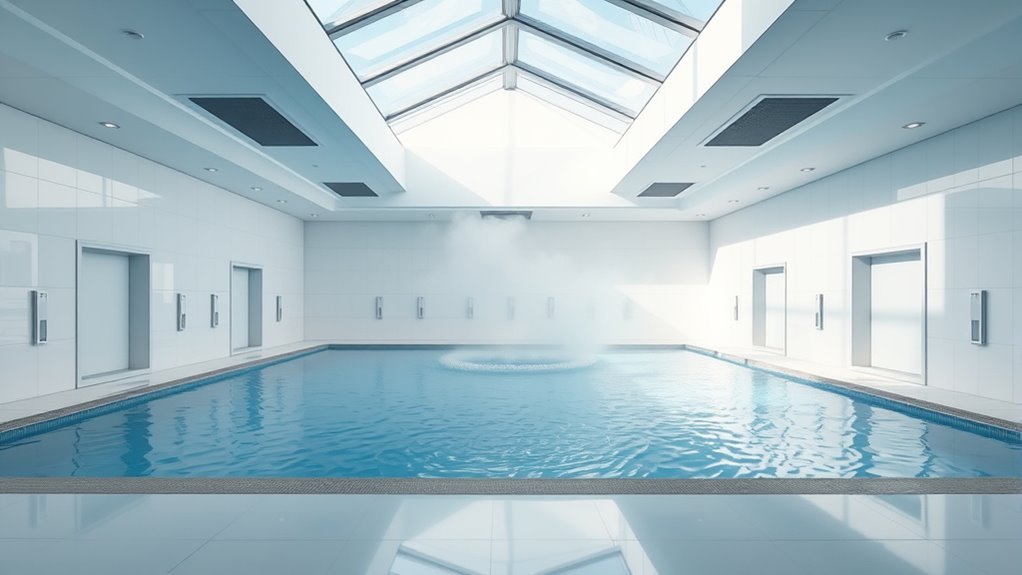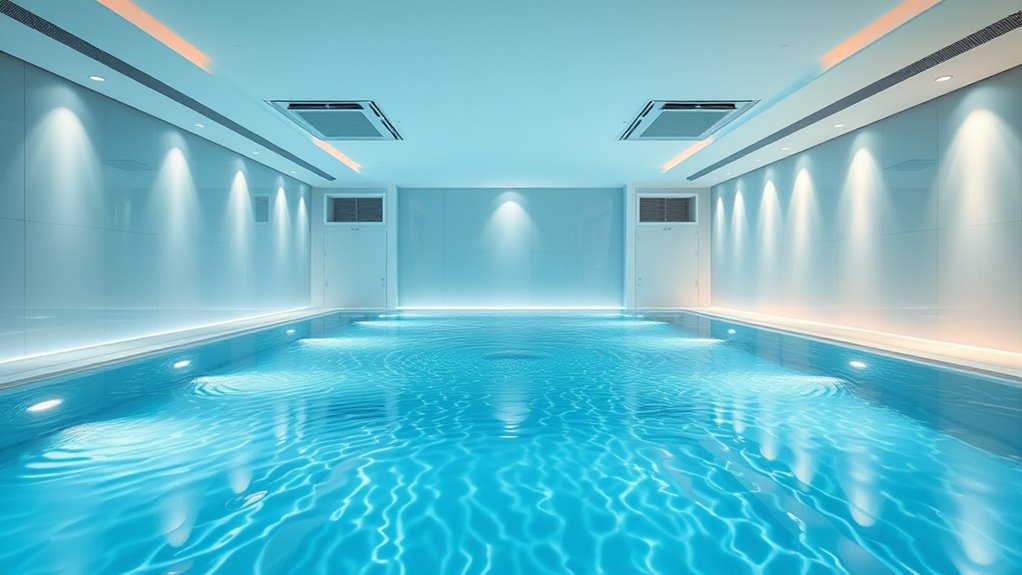To keep your indoor swim spa comfortable and safe, you need proper ventilation and moisture control. Use a venting system that exchanges indoor air with fresh outside air to reduce humidity, mold, and odors. Pair this with effective water filtration and heating to prevent condensation and humidity issues. Maintaining good airflow and temperature balance helps protect your space and furnishings. Want tips on setting up a healthy indoor environment? Keep exploring to learn more.
Key Takeaways
- Proper ventilation is essential to exchange indoor air and reduce humidity buildup around swim spas.
- Effective moisture control involves using dehumidifiers and exhaust fans to prevent mold and mildew growth.
- Maintaining consistent water temperature minimizes condensation and humidity-related issues inside the spa environment.
- Adequate space heating and insulation help regulate indoor humidity levels and improve energy efficiency.
- Regularly servicing filtration, ventilation, and heating systems ensures optimal moisture and air quality management.

Indoor swim spas offer a convenient and versatile way to enjoy aquatic exercise and relaxation year-round, regardless of weather conditions. When you install one indoors, managing moisture becomes essential to maintain a comfortable environment and protect your space. Proper ventilation and moisture control are key to preventing issues like mold, mildew, and structural damage. One of the main aspects to consider is water filtration. A high-quality filtration system ensures that the water remains clean, clear, and hygienic, reducing the need for harsh chemicals and minimizing airborne contaminants. When water is properly filtered, fewer particles and impurities evaporate into the air, helping keep your indoor environment healthier and more comfortable. Regular maintenance of your water filtration system also prolongs the lifespan of your spa, saving you money over time.
Another critical factor in indoor swim spa setup is space heating. Since you’re heating the water to enjoy year-round use, a reliable space heating system is necessary not just for comfort but also for energy efficiency. Modern swim spas often incorporate advanced heating technologies that quickly and evenly warm the water, reducing energy consumption and maintaining a consistent temperature. This consistency prevents temperature fluctuations that can cause condensation issues and excess humidity, which could affect your indoor space. When selecting a heater, look for options that are compatible with your overall HVAC system, so you can optimize energy use while ensuring the water remains at your preferred temperature. Additionally, integrating ventilation systems that effectively exchange indoor air with fresh outside air is vital for controlling humidity and maintaining a healthy environment.
Frequently Asked Questions
How Often Should I Inspect Indoor Swim Spa Ventilation Systems?
You should inspect your indoor swim spa ventilation system at least every three to six months. Regular ventilation maintenance helps prevent moisture buildup, which can lead to mold or damage. Check moisture sensors for proper function and cleanliness, ensuring accurate readings. If you notice increased humidity or condensation, inspect more frequently. Proper upkeep keeps your spa dry, safe, and running efficiently, so making routine inspections a part of your maintenance schedule is essential.
What Are the Signs of Excess Moisture Damage in My Home?
You might notice mold growth or musty odors in your home, which are clear signs of excess moisture damage. Did you know that mold can begin growing within 24-48 hours in damp environments? If your walls, ceilings, or furniture show discoloration or peeling paint, it’s a red flag. Keep an eye out for these signs to prevent structural damage and health issues caused by persistent moisture problems around your indoor swim spa.
Can I Upgrade My Current Ventilation System for Better Moisture Control?
Yes, you can upgrade your ventilation system for better moisture management. Ventilation upgrades, such as installing a more powerful exhaust fan or adding humidity sensors, can markedly improve air circulation and reduce excess moisture. These enhancements help prevent mold, condensation, and damage caused by high humidity levels. Consult a professional to assess your current system and recommend the best moisture management solutions tailored to your indoor swim spa area.
How Does Humidity Affect Indoor Air Quality Around Swim Spas?
High humidity levels around your swim spa can lower indoor air quality, causing discomfort and promoting mold growth. Excess moisture makes the air feel damp and stuffy, which can trigger allergies or respiratory issues. To improve air quality, you need good air circulation that helps remove excess humidity. Proper ventilation systems keep humidity in check, ensuring a healthier, more comfortable environment around your indoor swim spa.
Are There Specific Ventilation Standards for Indoor Swim Spa Installations?
Yes, there are specific ventilation standards and moisture regulations for indoor swim spa installations. You should follow local building codes and guidelines, which typically require proper ventilation systems to remove excess humidity and improve air quality. Adequate airflow and moisture control help prevent mold, corrosion, and structural damage. Make sure your setup complies with these standards to ensure a safe, comfortable environment and the longevity of your swim spa.
Conclusion
Now that you understand the importance of proper ventilation and moisture control, imagine what could happen if you overlook these essentials. Small issues can quickly escalate into costly damage or mold problems that threaten your entire space. Don’t leave your indoor swim spa vulnerable—stay vigilant and proactive. The key to enjoying your swim spa safely and worry-free lies in mastering these basics. Are you ready to take the necessary steps before it’s too late?









